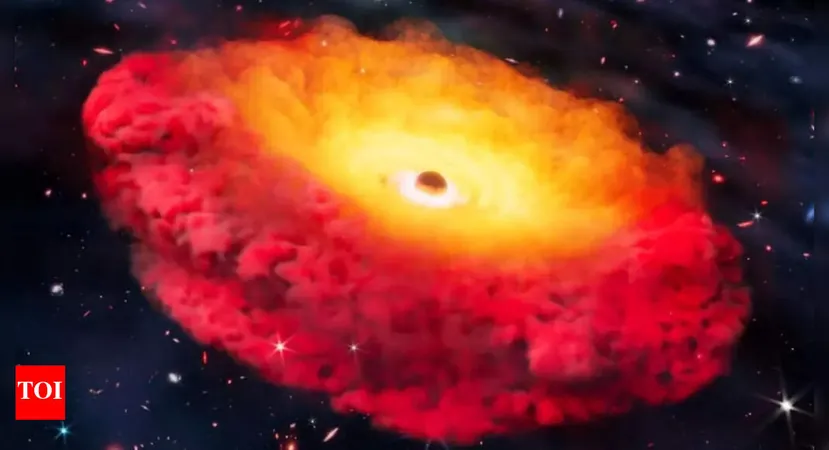
Unveiling the Universe's Oldest Black Hole: A Revolutionary Discovery by the James Webb Space Telescope
2025-08-28
Author: Wei Ling
Astronomers Make Groundbreaking Discovery: The Oldest Black Hole Ever Seen!
In a stunning revelation that rewrites cosmic history, astronomers using the James Webb Space Telescope (JWST) have identified the universe's oldest known black hole, nestled within the galaxy CAPERS-LRD-z9. Dating back a mere 500 million years after the Big Bang, this extraordinary black hole is estimated to possess a staggering mass between 38 million and 300 million times that of our Sun.
A Journey Back in Time: Discovering the Oldest Black Hole
This ancient black hole, aged 13.3 billion years, represents a pivotal moment in our understanding of the early universe. Emerging during a time of rapid cosmic development, this discovery was meticulously detailed in a recent study published in the *Astrophysical Journal Letters*. Its size and timing challenge long-held beliefs about the formation and evolution of black holes.
How Scientists Made This Astonishing Discovery
Conducted as part of the CANDELS-Area Prism Epoch of Reionization Survey (CAPERS), the investigation was spearheaded by a team from the University of Texas at Austin's Cosmic Frontier Center. Employing JWST's remarkable spectroscopic capabilities, they analyzed light emitted by the distant galaxy, uncovering compelling evidence of this supermassive black hole.
Unmasking the Little Red Dots
Remarkably, astronomers utilized the infrared instruments of JWST to peer into the depths of space, observing light that has trekked across the cosmos for over 13 billion years. Their focus on peculiar objects dubbed 'Little Red Dots'—small, brilliant points of light in distant images—led to the discovery. By investigating the light signatures from CAPERS-LRD-z9, they unveiled gas swirling at incredible speeds, indicative of matter being consumed by a black hole.
What are 'Little Red Dots'?
The term 'Little Red Dots' refers to these ancient galaxies' striking appearance in telescope images. This vivid red hue results from two key phenomena: the cosmic redshift, as the universe expands, stretching light into longer wavelengths, and dense clouds of gas that obscure blue light, enhancing their reddish tint.
The Mass of a Cosmic Giant
This early black hole's mass is nothing short of extraordinary. Initial estimates placed it at around 38 million solar masses, but new models suggest it could be as massive as 300 million solar masses, making it one of the largest black holes ever discovered. This rapid growth challenges existing theories surrounding black hole formation.
Why This Discovery Matters
The implications of this finding are profound, prompting scientists to reassess many foundational theories about the universe's early days. They are left contemplating two critical possibilities: that these black holes grew at unprecedented rates or that they formed from unusually massive seeds, erupting into existence in ways we had yet to understand. Researchers are now gearing up for more high-resolution observations with JWST to further explore these enigmatic 'Little Red Dots', potentially unveiling even more ancient black holes and shedding light on the mysteries of the early cosmos. As Steven Finkelstein, a co-author of the study, states, 'The discovery of Little Red Dots was a major surprise from early JWST data. Now we’re figuring out what they’re like and how they came to be.'
As the excitement continues, the James Webb Space Telescope proves to be a powerful tool in our quest to understand the universe’s earliest moments.

 Brasil (PT)
Brasil (PT)
 Canada (EN)
Canada (EN)
 Chile (ES)
Chile (ES)
 Česko (CS)
Česko (CS)
 대한민국 (KO)
대한민국 (KO)
 España (ES)
España (ES)
 France (FR)
France (FR)
 Hong Kong (EN)
Hong Kong (EN)
 Italia (IT)
Italia (IT)
 日本 (JA)
日本 (JA)
 Magyarország (HU)
Magyarország (HU)
 Norge (NO)
Norge (NO)
 Polska (PL)
Polska (PL)
 Schweiz (DE)
Schweiz (DE)
 Singapore (EN)
Singapore (EN)
 Sverige (SV)
Sverige (SV)
 Suomi (FI)
Suomi (FI)
 Türkiye (TR)
Türkiye (TR)
 الإمارات العربية المتحدة (AR)
الإمارات العربية المتحدة (AR)